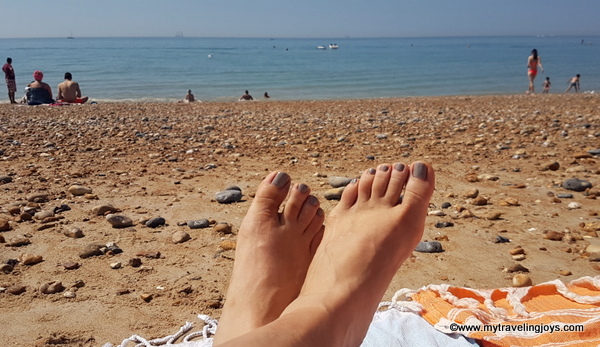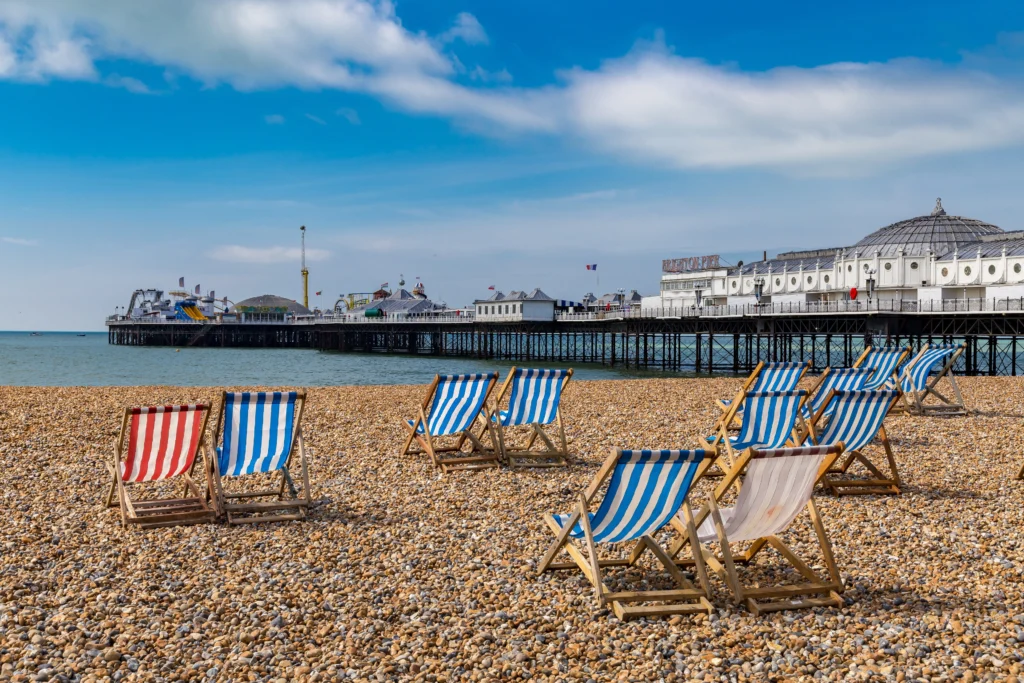Brighton Beach in the UK is known for its pebble beach, which gives it a stony appearance. The beach is made up of smooth, rounded stones of various sizes rather than sand. This unique feature is due to the geological makeup of the area and the way the waves and currents interact with the coastline.
The pebbles found on Brighton Beach and similar areas along the English Channel are the result of erosion and the movement of sediment along the coast over thousands of years. The rocks and stones have been worn down by the action of the waves, gradually becoming smaller and smoother.
Brighton Beach’s stony nature has become a characteristic feature of the area, attracting tourists and visitors who appreciate its distinctive appearance and the sound of the pebbles being moved by the waves.
How did geological forces shape Brighton Beach’s stony nature?

Brighton Beach, located in Brooklyn, New York, has its geological characteristics primarily shaped by glacial processes during the last Ice Age, which occurred around 20,000 years ago. During this period, the region was covered by massive ice sheets that extended from the polar regions.
Glaciers are powerful agents of erosion and transportation. As the glaciers advanced, they scoured the land, picking up various sizes of rocks, sand, and sediment. The movement of these glaciers, along with the weight of the ice, crushed and ground the rocks beneath them. This process, known as glaciation, resulted in the formation of various sedimentary deposits and the creation of different types of sedimentary rocks.
As the glaciers retreated, they left behind a mix of sediments and rocks that formed what is now known as the terminal moraine. The terminal moraine is a deposit of rocks and other debris that marks the furthest extent of the glacier’s advance. Brighton Beach is situated along part of this terminal moraine.
The rocks found on Brighton Beach today are primarily composed of glacial deposits, including various types of sedimentary rocks, such as sandstone, siltstone, and shale. These rocks were transported and deposited by the retreating glaciers, contributing to the stony nature of the beach.
Additionally, the ongoing processes of erosion caused by waves, wind, and weathering continue to shape the coastline of Brighton Beach, influencing the size and arrangement of the rocks found there.
What processes form the distinctive pebbles on Brighton Beach?

The distinctive pebbles found on Brighton Beach, like many pebble beaches worldwide, are primarily formed through a combination of geological processes involving erosion, weathering, and transportation.
Weathering
The process begins with the breakdown of larger rocks into smaller fragments. Weathering occurs through various mechanisms, including physical weathering (such as freeze-thaw cycles, where water seeps into cracks, freezes, and expands, breaking rocks apart) and chemical weathering (like oxidation or dissolution).
Transportation
Once rocks are weathered and broken down into smaller pieces, they are transported to the coast via rivers, streams, and other water bodies. In the case of Brighton Beach, these rock fragments were likely transported by rivers and streams from their source areas further inland.
Wave action
When these smaller rock fragments, ranging in size from gravel to pebbles, reach the coastline, they are subject to the constant action of waves. The waves continuously crash onto the shore, carrying these rock fragments and tumbling them against each other and the rocky shore.
Abrasion
This constant tumbling action causes further erosion and abrasion, smoothing and rounding the edges of the rock fragments. Over time, the rough edges are worn away, and the rocks become rounded and polished, forming the characteristic pebbles found on Brighton Beach.
Sorting
Different sizes and types of rock fragments may be sorted by the action of waves, resulting in layers of varying pebble sizes along the beach.
The specific geology of the area, including the types of rocks present in the region, influences the composition and color of the pebbles found on the beach. In the case of Brighton Beach, the pebbles are primarily made up of various sedimentary rocks that have undergone these processes of erosion, transportation, and abrasion, resulting in the rounded and smooth appearance observed on the beach.
How do the unique characteristics of Brighton Beach’s pebbles attract visitors?
Brighton Beach’s unique pebbles attract visitors due to their distinctiveness, aesthetic appeal, and the sensory experience they offer. Several reasons contribute to their attraction:
Uniqueness and Diversity
The pebbles on Brighton Beach come in various shapes, sizes, colors, and textures. Visitors are intrigued by the diversity and uniqueness of these pebbles, which can range from small, smooth, multicolored stones to larger, more intricate ones.
Scenic Beauty
The contrast of the pebbles against the sandy beach and the ocean creates a visually stunning and picturesque setting. The colorful and polished appearance of the pebbles adds to the natural beauty of the shoreline, making it an appealing spot for visitors and photographers.
Tactile Experience
Many people are drawn to the tactile experience of walking on a pebble beach. The smoothness and rounded edges of the pebbles provide a distinct sensation underfoot, making it an enjoyable and sensory experience for beachgoers.
Collecting and Souvenirs
Collecting pebbles can be a popular activity for visitors, especially for those interested in nature or looking for unique souvenirs. People often enjoy selecting and collecting pebbles of different shapes, colors, and sizes as keepsakes or mementos from their visit.
Relaxation and Meditation
The tranquil ambiance of the beach, combined with the soothing sound of waves and the tactile experience of handling pebbles, can create a calming and relaxing atmosphere. Visitors often find it a peaceful place for contemplation, meditation, or simply unwinding by the shore.
Nature and Geology Enthusiasts
For individuals interested in geology, the unique composition of the pebbles can be fascinating. Observing the various types of rocks and minerals present in the pebbles can be an educational and engaging experience for enthusiasts.
Overall, the distinctive characteristics of Brighton Beach’s pebbles appeal to a wide range of visitors, from those seeking natural beauty and relaxation to those interested in nature, geology, or simply enjoying a unique sensory experience by the sea. The combination of visual appeal, tactile sensations, and the calming atmosphere makes it an attractive destination for many beach enthusiasts and tourists.
FAQ’s
Can I take rocks from Brighton Beach?
Removing rocks or pebbles from Brighton Beach is generally discouraged to preserve the natural environment and ecosystem of the beach.
Is Brighton a sand or stone?
Brighton Beach primarily consists of pebbles and stones rather than sand, giving it a stony appearance.
Why are English beaches stony?
English beaches often have a stony composition due to geological factors, coastal erosion, and the action of waves over time, resulting in the formation of pebbles and stones.
How old are stones on a beach?
Stones on a beach can vary widely in age, ranging from hundreds to millions of years old, depending on the type of rock and geological history of the area.
Are Pebble Beaches natural?
Yes, pebble beaches are natural formations, typically formed by the erosion and breakdown of rocks and minerals by natural forces like waves and weathering.
How many stones are on Brighton Beach?
The exact number of stones on Brighton Beach varies and is difficult to quantify, as the beach is covered with countless pebbles and stones of different sizes and shapes.
Final Words
In conclusion, Brighton Beach is stony because of how rocks get worn down by the waves, making them into pebbles. These pebbles form a unique feature of the beach, different from sandy beaches that people usually see. The stony nature of Brighton Beach is a big reason why tourists like to visit—it’s something special and different. The beach’s charm lies in these smooth pebbles, which have been shaped by the sea over a long time. Overall, Brighton Beach’s stony appearance is a result of natural processes and adds to its appeal for visitors.

